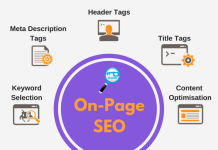World of Technical SEO
Welcome to the ultimate guide to Technical SEO, where we demystify the intricate world of optimizing your website for search engines. In this guide, we’ll break down Technical SEO into its fundamental components, helping you understand its significance, how it differs from other forms of SEO, and the best practices for optimizing your site for search engines.
In the digital age, a strong online presence is key to success, and Technical SEO plays a pivotal role in achieving that. It’s not just about crafting compelling content or building backlinks; it’s about ensuring your website’s technical aspects are in optimal shape. But before we delve into the nitty-gritty details, let’s start with the basics.

Technical SEO Fundamentals
What Is Technical SEO?
Technical SEO, often referred to as the backbone of SEO, is a subset of SEO that focuses on optimizing the technical elements of your website to enhance its visibility in search engine results. It’s about ensuring that search engines can crawl, index, and understand your site effectively.
Why It Matters
Imagine your website as a library, and search engines as the librarians. To have your books (web pages) easily accessible, you need to organize them efficiently. That’s precisely what Technical SEO does—it ensures your website is well-organized and user-friendly for both search engines and human visitors.
How It Differs
Technical SEO differs from on-page and off-page SEO. While on-page SEO is about optimizing individual web pages and their content, and off-page SEO is about activities outside your website (like building backlinks), Technical SEO focuses on your site’s infrastructure, making it accessible and comprehensible to search engines.
To give you a taste of what’s to come, we’ll explore some of the core components of Technical SEO, starting with crawlability and indexability.
The Pillars of Technical SEO
Crawlability
Crawlability refers to the ability of search engine bots (crawlers) to navigate and scan your website. If your site isn’t crawlable, search engines won’t be able to index your pages effectively, which can significantly impact your search rankings.
Indexability
Indexability is about ensuring that your web pages are included in the search engine’s index. When your pages are indexed, they have the potential to appear in search results. However, indexability issues can prevent this from happening.
The Anatomy of Technical SEO
Now that we’ve established the significance of Technical SEO and its core pillars, it’s time to dive into the intricate details of optimizing your website’s technical aspects. This section will unravel the essential elements that make up Technical SEO and help you grasp the finer nuances of website structure, site speed, mobile optimization, and effective indexation and crawling.
Website Structure
Your website’s structure is like the architecture of a building—it impacts how users navigate your site and how search engines interpret and index your content.
URL Structure and Hierarchy
- A clear and organized URL structure helps users and search engines understand the hierarchy of your content.
- For instance, a URL like “yourwebsite.com/blog/technical-seo/” is far more informative than “yourwebsite.com/page123.”
Navigation
- A user-friendly navigation menu guides visitors through your site, making it easy for them to find what they’re looking for.
- Effective navigation also helps search engines understand the relationships between different pages.
In the upcoming sections, we’ll explore the principles of crafting an ideal URL structure and creating a user-friendly navigation system that benefits both your audience and search engine rankings.
Site Speed and Performance
Website speed is not just about user experience; it’s a critical factor for SEO. Search engines prefer fast-loading websites because they deliver a better user experience. We’ll break down the essentials of site speed and performance optimization.
The Importance of Site Speed
- Slow-loading pages can frustrate users, leading to higher bounce rates and reduced conversions.
- Search engines, like Google, consider page speed as a ranking factor, meaning faster websites tend to rank higher in search results.
Optimization Techniques
- Minimize large images: Large images can significantly slow down your site. Optimizing and compressing images can help.
- Leverage browser caching: This technique reduces the time it takes for your pages to load by storing frequently accessed data on a user’s device.
- Optimize server response times: A speedy server response is essential for fast-loading pages.
These optimization strategies will help enhance your website’s performance and, in turn, its SEO ranking. In the next section, we’ll tackle the critical aspect of mobile optimization.
Mobile Optimization
Mobile optimization has evolved from being a recommendation to an SEO necessity. With the advent of mobile-first indexing, Google primarily uses the mobile version of a site for ranking and indexing. Ensuring your website is mobile-friendly is not an option; it’s a requirement.
Mobile-Friendly Design
- A responsive design adjusts to different screen sizes, ensuring your content looks good and functions well on mobile devices.
- This design approach caters to users on smartphones, tablets, and desktops.
Mobile-First Indexing
- Google predominantly uses the mobile version of your site for ranking. If your site isn’t mobile-friendly, your search rankings may suffer.
In the sections ahead, we’ll explore the intricacies of mobile optimization, providing insights on responsive design, mobile SEO best practices, and tools to test your website’s mobile-friendliness.
Indexation and Crawling
In the ever-expanding digital landscape, effective indexation and crawling are paramount. Without proper indexation, your website might remain invisible to search engines and, consequently, to potential visitors.
Search Engine Crawlers
- Search engine bots (crawlers) systematically scan websites, collecting data about the content.
- Understanding how these crawlers operate is essential to ensuring your website is thoroughly indexed.
Technical SEO Best Practices
You’re on the path to mastering Technical SEO, and it’s time to delve into best practices that will ensure your website is not just technically sound but also poised for SEO success. In this section, we’ll explore some advanced concepts and strategies to optimize your site to its fullest potential.
Schema Markup
Schema markup is an advanced yet highly valuable tool in Technical SEO. It helps search engines understand the context of your content, resulting in the display of rich snippets in search results.
Enhancing Search Results
- Schema markup provides structured data that gives search engines a deeper understanding of your content.
- The outcome is often rich snippets, which present more information in search results and attract more clicks.
In the forthcoming sections, we’ll unravel the world of schema markup, examining its various types and how to implement it effectively on your website.
XML Sitemaps and Robots.txt
XML sitemaps and the robots.txt file are technical elements that might not be visible to your site’s visitors, but they play a crucial role in ensuring search engines navigate your site efficiently.
Guiding Search Engine Crawlers
- XML sitemaps provide a roadmap for search engine crawlers, making it easier for them to index your website.
- The robots.txt file, on the other hand, controls what areas of your site crawlers can or cannot access.
In the upcoming sections, we’ll explore the significance of these elements and guide you on their effective implementation to enhance your site’s SEO.
Canonicalization and Duplicate Content
Duplicate content can confuse search engines and dilute the visibility of your pages. Canonicalization and addressing duplicate content are strategies to maintain the integrity of your website’s SEO.
Identifying Duplicate Content
- Duplicate content can occur through various means, such as URL variations, session IDs, or syndicated content.
- Search engines may have difficulty determining which version to display in search results.
We’ll delve into strategies to address duplicate content issues, including the use of canonical tags, which signal the preferred version of a page to search engines.
HTTPS and Security
In an age of increasing cyber threats and privacy concerns, securing your website is not just about user safety—it’s also about SEO. Search engines favor secure websites, and HTTPS is a strong indicator of security.
The Importance of a Secure Website
- HTTPS encrypts data between the user’s browser and your website, safeguarding user information.
- Google has confirmed that it uses HTTPS as a ranking signal.
In the subsequent sections, we’ll explore the importance of a secure website, the process of implementing HTTPS, and additional security measures to protect your site from vulnerabilities.
Technical SEO Tools
In the world of Technical SEO, having the right tools at your disposal can make all the difference. These tools simplify the optimization process, offering insights into your site’s performance and areas for improvement.
SEO Auditing Tools
SEO auditing tools are invaluable for a comprehensive evaluation of your website’s technical aspects. These tools scan your site and provide reports on issues that may be affecting your SEO.
The Power of SEO Audit
- SEO audit tools can identify a wide range of technical issues, from broken links to slow page speed.
- They offer actionable insights, allowing you to address problems and enhance your site’s performance.
In the sections ahead, we’ll review some popular SEO auditing tools that can assist you in improving your site’s technical SEO.
Google Search Console
Google Search Console is a set of webmaster tools provided by Google. These tools are a must-have for website owners, webmasters, and SEO professionals.
Harnessing Google’s Tools
- Google Search Console offers a suite of diagnostic and reporting tools.
- It provides essential data and insights into how Google views your site and how it performs in search results.
In the forthcoming sections, we’ll explore the key features of Google Search Console, how to set it up, and how to utilize the data and insights it provides to enhance your Technical SEO.
Technical SEO Challenges and Problem-Solving
Technical SEO is not without its challenges, and it’s essential to understand the common issues that can affect your website’s SEO performance. Equally important is knowing how to diagnose and rectify these challenges.
Common Technical SEO Challenges
We’ll start by identifying some of the typical challenges faced in Technical SEO. Recognizing these issues is the first step toward resolving them.
Identifying Common Issues
- Common issues include crawl errors, duplicate content, broken links, and slow page speed.
- These issues can have a detrimental impact on your site’s SEO and user experience.
Problem-Solving Strategies
Once you’ve identified the challenges, it’s time to implement strategies to address and resolve them.
Diagnosing and Fixing Issues
- Diagnosing the root causes of problems is crucial. It could be an issue with your site structure, code, or server.
- We’ll provide you with a toolkit of strategies to fix these issues, ensuring your website remains SEO-friendly.
Future of Technical SEO
As you embark on your journey to master Technical SEO, it’s essential to consider the evolving landscape of the digital world. The field of SEO, including its technical aspects, is constantly changing, influenced by factors such as algorithm updates and emerging technologies. In this section, we’ll explore what the future holds for Technical SEO and how you can prepare for it.
The Evolving Landscape
The future of Technical SEO is closely tied to the ever-evolving algorithms and technologies employed by search engines.
Impact of AI and Voice Search
- Artificial intelligence (AI) is increasingly used by search engines to deliver more personalized search results.
- Voice search, powered by AI, is on the rise, shaping how users interact with search engines.
In the subsequent sections, we’ll discuss how AI and voice search are influencing Technical SEO and what you can do to adapt to these changes.
Staying Updated
In the dynamic field of SEO, staying informed about the latest trends and algorithm updates is critical to maintaining your site’s visibility.
The Importance of Continuous Learning
- SEO is an ever-evolving field, and to remain competitive, you must keep learning.
- Staying updated allows you to adapt your strategies to industry changes.
We’ll explore resources and strategies for staying informed about the latest trends in Technical SEO, including SEO news sources, webinars, and SEO communities and forums.
By keeping an eye on the horizon and staying informed about industry changes, you’ll be well-prepared to adapt your Technical SEO strategies and ensure your website’s continued success.
FAQs
What are the key components of Technical SEO?
Technical SEO includes aspects like crawlability, indexability, mobile-friendliness, site speed, structured data (schema markup), and more. It ensures search engines can efficiently crawl and understand your site.
How does site speed affect SEO?
Site speed is a ranking factor for search engines. Faster-loading websites provide a better user experience and tend to rank higher in search results.
What is mobile-first indexing?
Mobile-first indexing is a shift in how Google ranks and indexes websites. It primarily uses the mobile version of a site for ranking, making mobile optimization crucial.
How do I improve indexation and crawling?
You can improve indexation and crawling by ensuring a clear website structure, optimizing your XML sitemap, and using a well-constructed robots.txt file.
What is the significance of structured data in Technical SEO?
Structured data, facilitated by schema markup, provides valuable context to search engines, resulting in rich snippets in search results. Rich snippets enhance your website’s visibility and click-through rates.
How can I deal with duplicate content issues?
To address duplicate content, you can implement canonical tags, specifying the preferred version of a page to search engines. You can also resolve content duplication through 301 redirects and parameter handling.
Why is a secure website important for SEO?
A secure website with HTTPS is crucial for SEO because it ensures data privacy and security for users. Google considers HTTPS as a ranking signal, so secure websites tend to rank higher in search results.
Which SEO auditing tools are recommended for Technical SEO?
Popular SEO auditing tools include Screaming Frog, Ahrefs Site Audit, SEMrush Site Audit, and Google’s own Google Search Console. These tools help identify technical issues that affect SEO.
How can I diagnose and fix common Technical SEO challenges?
Diagnosing and solving common challenges involves using SEO auditing tools, reviewing crawl reports, and checking Google Search Console for errors. Once issues are identified, you can implement solutions such as fixing broken links, resolving crawl errors, and improving site speed.
What are the upcoming trends in Technical SEO?
Upcoming trends in Technical SEO include the increasing use of AI by search engines for personalized search results. Voice search, powered by AI, is also becoming more prevalent. Staying informed about these trends is crucial to adapt your SEO strategies effectively.
Conclusion
As we wrap up this comprehensive guide to Technical SEO, you’ve journeyed through the intricate world of optimizing your website for search engines. You’ve learned what Technical SEO is, its fundamental components, and its significance in the digital landscape. While the world of SEO is vast and constantly evolving, you now have a solid foundation to enhance your website’s technical aspects and, in turn, its visibility in search engine results.
Throughout this guide, we’ve explored the pillars of Technical SEO, delving into crawl ability, indexability, mobile optimization, site speed, and the essential role of structured data through schema markup. We’ve also touched on key best practices, including the use of XML sitemaps, and robots.txt files, addressing duplicate content, and securing your website with HTTPS.
To help you navigate the technical landscape effectively, we’ve introduced you to vital tools, including SEO auditing tools and Google Search Console. Additionally, you’ve gained insights into diagnosing and resolving common Technical SEO challenges, ensuring your website remains optimized for search engines.
In a rapidly changing digital world, staying informed is key to success. In our exploration of the future of Technical SEO, we discussed the influence of AI and voice search and the importance of continuous learning and adaptation. By keeping a watchful eye on industry trends and emerging technologies, you’ll be better equipped to maintain your website’s competitive edge.
Remember, Technical SEO is not just about search engine rankings; it’s about delivering a seamless and user-friendly experience to your visitors. The technical foundation of your website lays the groundwork for engaging content and effective marketing.
Now that you’re well-versed in Technical SEO, it’s time to put your knowledge into practice. Apply the strategies and best practices you’ve learned to optimize your website, enhance your search engine visibility, and embark on the path to online success.
Thank you for accompanying us on this journey through the world of Technical SEO. If you have any further questions or specific topics you’d like to explore, feel free to reach out. Happy optimizing!




